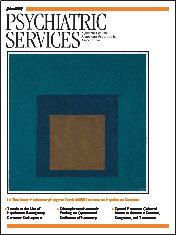The Impact of Capitated Financing on Psychiatric Emergency Services
Abstract
OBJECTIVE: Studies of capitated financing of mental health services have generally focused on the cost and utilization of services. Relatively little research has addressed whether capitation has an impact on the effectiveness of the mental health system as a whole. This study examined the impact of capitation on hospital emergency department visits, a widely cited indicator of the effectiveness of the other components of the system. METHODS: In 1995 Colorado's Medicaid program instituted capitation for mental health services in two areas of the state, one in which reimbursement of not-for-profit providers was directly capitated and another in which not-for-profit providers partnered with a for-profit managed behavioral health organization. The analysis examined variation over time in the number of emergency department visits by adults who had a primary mental or substance use disorder. Using interrupted time-series methods, visits in areas where reimbursement was capitated were compared with visits in areas where providers continued to be reimbursed on a fee-for-service basis. A total of 105 weeks for each area was examined; capitation was implemented at week 53. RESULTS: The number of psychiatric emergencies treated in capitated areas declined by 814 (28 percent) below the 2,908 psychiatric emergencies expected from trends, cycles, and levels in fee-for-service areas. Findings were similar for for-profit and not-for-profit areas. The decrease persisted through the end of the first year after capitation. CONCLUSIONS: In Colorado the implementation of capitation was associated with a sustained decrease in utilization of psychiatric emergency services provided by hospital emergency departments. Our findings suggest that capitation does not necessarily reduce the quality of care provided to clients.



